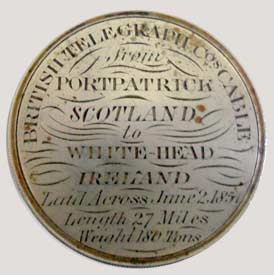British Telegraph Company Cable – Port Patrick, Scotland, to Donaghadee (Whitehead), Ireland (27 miles)
The six-core cable was manufactured by the Gutta Percha Company of London and armoured and laid on 2 June 1854 by R S Newall & Company of Gateshead to the same pattern as that used by the Magnetic company in 1853. The steamer Monarch, chartered from the International Telegraph Company by R S Newall, accompanied by the tugs Wizard and Conqueror, successfully laid the twenty-seven mile cable from Port Patrick to Whitehead, near Donaghadee, on June 2, 1854.
To connect with its domestic network the British Telegraph Company laid an underground circuit from Whitehead to Carrickfergus for Belfast, and another to Stranraer and Ayr for Glasgow in 1855. The connection to Dumfries for London was not completed until March 1855. It used Highton’s single needle telegraph in its circuits.
The Magnetic and British companies merged in 1857 to form the British & Irish Magnetic Telegraph Company. The combined firm then possessed two cables from Port Patrick to Donaghadee, with three magneto circuits and six galvanic circuits. This capacity gave the new company a virtual monopoly of traffic to Ireland for several years as the competition had only two circuits to the city of Dublin.
In its issue of 5 June 1854, the Belfast News-Letter published this description of the laying of the cable:
BRITISH ELECTRIC TELEGRAPH COMPANY—ANOTHER SUBMARINE CABLE.
The contractor and employees of this company have succeeded in submerging a cable between the Scottish and Irish coasts of the North Channel, with a view to the extension of their line throughout this country. On Friday morning last [June 2nd], they started from a small bay near Portpatrick, a short distance from the point where the submarine cable of the Magnetic Telegraph Company was first payed out, having their line on board the Monarch steamer. The Monarch was accompanied by two steam-tugs—the Wizard and the Conqueror—the former piloting the expedition. The vessels arrived in the course of the same afternoon, after successfully completing their task, at the coast-guard station, a little to the North of Whitehead, where the line was at once attached to the shore and connected with the telegraphic instruments, a temporary wooden structure having been previously erected to serve as an office.
The communication between the two coasts having been thus easily and effectively established—no difficulty or delay being encountered on the passage across the channel—a message was despatched from the Whitehead to Portpatrick, announcing the fact, and giving notice that the Conqueror was about to return. The message was immediately answered, and the tug started at three o'clock in the afternoon. Since then, upwards of a hundred messages have been sent and replied to, so that there can be no doubt that this experiment has been quite successful.
We have had an opportunity of witnessing the working of the line, and the arrangements which have been made since its submersion. The cable is twenty-seven miles in length, exclusive of many hundred yards, which, not being required, now lie in a coil opposite the Coast-guard station at Whitehead. It is about as thick as a man's wrist, and consists of six copper wires, well coated with gutta-percha, firmly wrapped in tarred hemp, and the whole protected by twelve iron wires of substantial thickness, to which are given a spiral twist. The company intend immediately to carry on their wires, through subterranean pipes, to the railway station at Carrickfergus, and thence to Belfast, along the Carrickfergus branch of the Ballymena railway. We understand that they are to open an office in Belfast, as soon as these minor arrangements shall have been commenced.

Cable images courtesy of Eddie Vowles |

6 copper wires, No. 16 gauge,
covered with gutta percha,
to No. 2 gauge, served with 12 iron wires, No. 2 gauge |

British Telegraph Co.s Cable
from Portpatrick Scotland
to White-Head Ireland
Laid Across June 2, 1854
Length 27 Miles
Weight 180 Tons |
The contractor for the work is Mr. Newall, of Gateshead, and the patentee of the invention which the company have adopted is Mr. Highton, whose brother, Mr. Alfred Highton, superintended the submersion of the cable, and is the official inspector of this district. Mr. Watson, the assistant-superintendent and inspector, is now in care of the temporary station at Whitehead, and to him we are indebted for the information we have now given our readers, and for the greatest courtesy in enabling us to test the working of the line.
In Scotland, this line establishes a communication from Portpatrick, via Stranraer, Ayr, and Dumfries, with the company's other lines which proceed to Liverpool and London. Mr. Newall is, we understand, now at Portpatrick, making daily experiments to test the efficiency of the cable. The event has created quite a sensation along the Antrim coast, where the appearance of the strange steamers hovering so near the lonely beach was attributed to anything but a peaceful purpose.
For further information on early Anglo-Irish cables, see this article by Steve Roberts |

